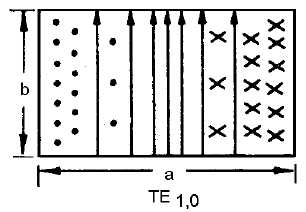1-27
In the transverse magnetic (TM) mode, the entire magnetic field is in the transverse plane and has no
portion parallel to the length axis.
Since there are several TE and TM modes, subscripts are used to complete the description of the
field pattern. In rectangular waveguides, the first subscript indicates the number of half-wave patterns in
the "a" dimension, and the second subscript indicates the number of half-wave patterns in the "b"
dimension.
The dominant mode for rectangular waveguides is shown in figure 1-36. It is designated as the TE
mode because the E fields are perpendicular to the "a" walls. The first subscript is 1 since there is only
one half-wave pattern across the "a" dimension. There are no E-field patterns across the "b" dimension, so
the second subscript is 0. The complete mode description of the dominant mode in rectangular
waveguides is TE1,0. Subsequent descriptions of waveguide operation in this text will assume the
dominant (TE1,0) mode unless otherwise noted.
Figure 1-36.—Dominant mode in a rectangular waveguide.
A similar system is used to identify the modes of circular waveguides. The general classification of
TE and TM is true for both circular and rectangular waveguides. In circular waveguides the subscripts
have a different meaning. The first subscript indicates the number of full-wave patterns around the
circumference of the waveguide. The second subscript indicates the number of half-wave patterns across
the diameter.
In the circular waveguide in figure 1-37, the E field is perpendicular to the length of the waveguide
with no E lines parallel to the direction of propagation. Thus, it must be classified as operating in the TE
mode. If you follow the E line pattern in a counterclockwise direction starting at the top, the E lines go
from zero, through maximum positive (tail of arrows), back to zero, through maximum negative (head of
arrows), and then back to zero again. This is one full wave, so the first subscript is 1. Along the diameter,
the E lines go from zero through maximum and back to zero, making a half-wave variation. The second
subscript, therefore, is also 1. TE
1,1
is the complete mode description of the dominant mode in circular
waveguides. Several modes are possible in both circular and rectangular waveguides. Figure 1-38
illustrates several different modes that can be used to verify the mode numbering system.

